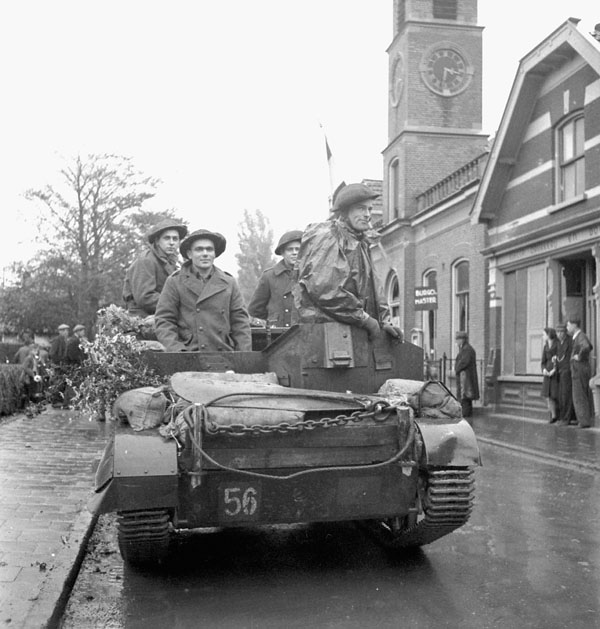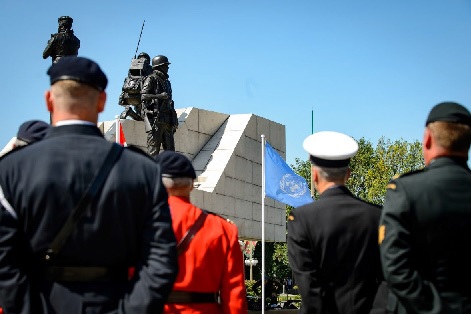Canada Remembers Times - 2019 Edition - Page 2
Looking back on Afghanistan
Canadian Armed Forces member in Afghanistan filling backpacks with school supplies to help local children in 2011.
Photo: Department of National Defence AT2011-0050-01a
Our country’s best-known military effort in recent years was Canada’s mission in Afghanistan. More than 40,000 Canadian Armed Forces members served in the Afghanistan theatre of operations between 2001 and 2014, making it our largest deployment of troops since the Second World War.
While combat operations and working in a very hostile environment were a major part of what our men and women in uniform experienced there, particularly when they were based in the volatile Kandahar Province, that was only part of the picture.
Many Veterans also remember with pride the humanitarian, infrastructure development and nation-building projects that Canada undertook in Afghanistan. Efforts like constructing a major dam, road-building, helping girls access schooling and training the Afghan police and military forces were important elements of Canada’s overall mission.
Service in Afghanistan was often very dangerous and some 158 Canadian Armed Forces members lost their lives in theatre. Being in stressful situations and seeing acts of violence all around you, particularly when they harm your comrades, can take a heavy psychological toll. The wounds of military service are not always visible and a difficult legacy for many Veterans of the Afghanistan mission has been post-traumatic stress disorder and other occupational stress injuries.
March 2019 marked the 5th anniversary of the end of Canada’s mission in Afghanistan and this milestone was commemorated with a ceremony at the National War Memorial in Ottawa. We remember all those who served and those who gave their lives in the cause of peace and freedom.
70 years of NATO
A Canadian Leopard tank pausing beside a house during NATO exercises in West Germany in September 1982.
Photo: Library and Archives Canada
The origins of the North Atlantic Treaty Organization (NATO) date back to the beginning of the Cold War in the late 1940s. The Second World War had come to an end but tensions again arose as the communist Soviet Union competed for international power with the democratic countries of the west. The possibility of conflict breaking out was very real. The western nations sought to form a military alliance and NATO was established on April 4, 1949, with Canada being one of its 12 founding members.
Thousands of Canadian soldiers and airmen were stationed in Western Europe from the early 1950s to the early 1990s to help counterbalance the communist forces amassed in Eastern Europe. Our warships were also part of NATO fleets on the Atlantic Ocean and Mediterranean Sea.
The collapse of the Berlin Wall in 1989 was soon followed by the fall of communist regimes in the Soviet Union and Eastern Europe. NATO, however, would prove its continued relevance with multinational security missions beginning in the Balkans in the mid-1990s, Afghanistan in the 2000s, and Libya in 2011. Since 2014, Canadian Armed Forces members have served with NATO forces in places like Poland, Latvia, Romania and the Black Sea as part of Operation Reassurance. Despite many changes in the world, NATO remains strong. Today it has 29 member nations, and Canada is still a key contributor even 70 years later.
Clearing the Scheldt
Royal Hamilton Light Infantry soldiers riding through a newly-liberated Dutch village in October 1944 during the Battle of the Scheldt.
Photo: Library and Archives Canada PA-138420
The year 1944 was pivotal in the Second World War as it saw the beginning of the liberation of Western Europe after more than four years of harsh German occupation. Following victory in the Battle of Normandy in France that summer, the Allies pushed north and east in pursuit of the retreating enemy forces. The Allies had to capture a large port on the continent to keep their troops supplied with what they needed. The major Belgian port of Antwerp was liberated in early September but there was a problem; it was 80 kilometres from the open sea and ships had to navigate the West Scheldt estuary to reach the docks—a waterway that passed through parts of Belgium and the Netherlands still held by the Germans. The vital task of clearing its shores would largely fall to the First Canadian Army.
Much of the Battle of the Scheldt that autumn took place over flat and flooded terrain that offered little cover for the advancing Canadians. The heavy mud that stuck to soldiers and machines, the many dikes and canals that had to be crossed, and a battlehardened enemy made the campaign a nightmare. Indeed, some of the toughest fighting of the entire Second World War took place there but the Allies persevered. The final portion of the Scheldt was liberated by early November and shipping to Antwerp began flowing later that month.
More than 6,000 Canadian soldiers were killed or wounded in the bloody Battle of the Scheldt. The memory of the terrible fighting there would haunt many of our Veterans for years to come. This fall marks the 75th anniversary of this important campaign and the memory lives on.
A lifetime of service
Sir Eugène Fiset
Photo: Public domain
This year marks the 120th anniversary of the beginning of the South African War in October 1899. Many Canadians served during the conflict, including Eugène Fiset. Born in Rimouski, Quebec, in 1874, he joined the 89e Régiment at the young age of 16. He studied medicine at Laval University, graduating in time to volunteer as the regimental surgeon for the Royal Canadian Regiment which sailed to South Africa in 1899.
Fiset would see plenty of action overseas tending to the sick and wounded. He did not shy away from getting in the heat of the action. During the opening day of the Battle of Paardeberg on February 18, 1900, Fiset braved heavy enemy fire to treat wounded soldiers and help bring them back to safety. Eighteen Canadians died that day and 60 more were wounded. For his selfless actions during the conflict, Fiset was awarded the Queen’s Medal with four bars and later received the Distinguished Service Order.
After returning home, Fiset’s service to Canada continued. He rose through the ranks, eventually becoming a major-general during the First World War. Among other honours for his distinguished service, Fiset was knighted by King George V in 1917. After retiring from the military, Fiset became a respected politician, sitting in the House of Commons from 1924 to 1939, before serving as Lieutenant Governor of Quebec from 1939 to 1950.
Canadian peacekeepers in Cyprus
Canadian armoured vehicles patrolling
the Green Line in Cyprus.
Photo: Department of National Defence
One of Canada’s best-known peace support efforts has been on the Mediterranean island of Cyprus. After the country gained its independence from Britain in 1960, long-simmering tensions between its Greek and Turkish populations soon erupted into open violence. The United Nations intervened with a major peacekeeping mission that began in 1964—and Canadians were in Cyprus from the start.
Our soldiers helped maintain a fragile peace there for almost a decade until this balance was rocked in 1974 when thousands of troops from neighbouring Turkey invaded and occupied the northern portion of Cyprus. Canadian Armed Forces members suddenly found themselves in the middle of a war zone. The island would end up split into two parts, separated by a buffer zone running its full width called the “Green Line”—a difficult situation that continues today.
A large contingent of Canadians served in Cyprus until 1993, spending countless hours helping to patrol the Green Line and diffusing conflicts between the two sides. While we no longer have a large force based there, Canada’s military commitment continues today with Operation Snowgoose. More than 25,000 of our men and women in uniform have deployed to Cyprus over the years, with 28 losing their lives.
Standing up for peace
A National Peacekeepers’ Day ceremony at
Reconciliation: The Peacekeeping Monument in
Ottawa in 2018.
Photo: Department of National Defence
Canada is known around the world for its many contributions to international peace support efforts over the years. To mark this proud tradition of service, National Peacekeepers’ Day is observed in our country on August 9. This date is significant as it was on this day in 1974 that nine Canadian peacekeepers were killed in the Middle East when their transport plane was shot down while helping establish a new United Nations mission in the Golan Heights of Syria. It was the heaviest single-day loss our country has ever suffered in a peace support effort. Despite this tragic beginning, more than 12,000 Canadian Armed Forces members would serve in the Golan Heights over the decades that followed.
It has been 45 years since this incident but the memory of our fallen peacekeepers lives on every August in solemn ceremonies held in Ottawa and in communities across the country.
- Date modified:





